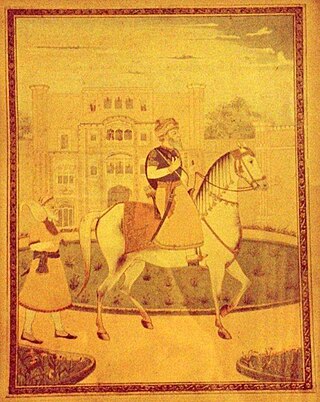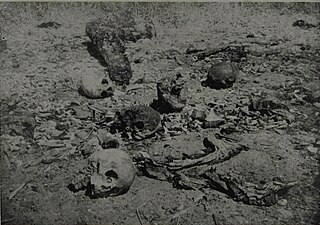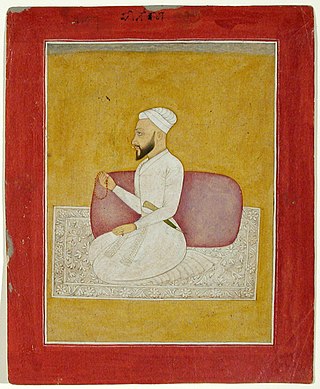
Hari Singh Nalwa was Commander-in-chief of the Sikh Khalsa Fauj, the army of the Sikh Empire. He is known for his role in the conquests of Kasur, Sialkot, Attock, Multan, Kashmir, Peshawar and Jamrud. Hari Singh Nalwa was responsible for expanding the frontier of Sikh Empire to beyond the Indus River right up to the mouth of the Khyber Pass. At the time of his death, the western boundary of the empire was Jamrud.

Jassa Singh Ramgarhia (1723–1803) was a prominent Sikh leader during the period of the Sikh Confederacy. He was the founder of the Ramgarhia Misl.

Sultan-ul-Qaum Sardar Jassa Singh Ahluwalia was a Sikh leader during the period of the Sikh Confederacy, being the Supreme Leader of the Dal Khalsa. He was also Misldar of the Ahluwalia Misl. This period was an interlude, lasting roughly from the time of the death of Banda Bahadur in 1716 to the founding of the Sikh Empire in 1801. He founded the Kapurthala State in 1772.

Vadda Ghalughara was the mass murder of unarmed Sikhs by the Afghan forces of the Durrani Empire during the years of Afghan influence in the Punjab region of the Indian subcontinent owing to the repeated incursions of Ahmad Shah Durrani in February 1762. It is distinguished from the Chhota Ghalughara. Mostly non-combatants were killed in the event, and an estimated that 10,000 to 50,000 Sikhs were killed on 5 February 1762.

The Battle of Nowshera was fought in Nowshera in March 1823 between the Yusufzai Afghans, supported by the Peshawar sardars, alongside Azim Khan Barakzai, the Afghan governor of Peshawar, where they would face the Sikh armies led by Maharaja Ranjit Singh. Azim Khan was a half-brother of Dost Mohammad Khan, future ruler of Kabul, and later Afghanistan. The battle was a victory for the Sikhs, successfully defeating Azim Khan's armies. This victory allowed them to begin to their occupation of the Peshawar Valley.

The Afghan–Sikh wars spanned from 1748 to 1837 in the Indian subcontinent, and saw multiple phases of fighting between the Durrani Empire and the Sikh Empire, mainly in and around Punjab region. The conflict's origins stemmed from the days of the Dal Khalsa, and continued after the Emirate of Kabul succeeded the Durrani Empire.

Adina Beg Khan was a Punjabi general and administrator who served as the last governor of the Punjab region of the Mughal Empire, including the provinces of Lahore and of Multan. He defeated the Afghans after rising to power and was recognised as the Nawab of Punjab by Mughal emperor Alamgir II, who also gave him title of Jang Bahadur.

Timur Shah Durrani, also known as Timur Shah Abdali or Taimur Shah Abdali was the second ruler of the Afghan Durrani Empire, from November 1772 until his death in 1793. An ethnic Pashtun, he was the second eldest son of Ahmad Shah Durrani.
The Battle of Kup was fought on 5 February 1762, between the Afghan forces of Ahmad Shah Durrani and the Sikhs, under the command of Jassa Singh Ahluwalia and Charat Singh. Ahmad Shah Durrani and the Afghan forces reached Malerkotla, west of Sirhind. Different sources give various estimates on how many sikhs were present. According to Tom Landsford, nearly 30,000 Sikh men, women, children, and elderly laid encamped. According to Narendra Sinha, 40,000 Sikhs were present. According to Hari Ram Gupta, 50,000 Sikh soldiers laid encamped at Kup while 5,000 non combatants laid encamped at Pind Garma. Abdali's forces outnumbered the Sikhs in hand-to-hand combat and the Sikhs couldn't use their usual tactics of hit and run, but had to engage in battle while protecting the civilians at the same time. With surprise attack, the Sikhs threw a human ring around civilians as protection and fought the battle killing several thousand Afghans. Abdali was able to break the ring and carried out a full scale massacre of the Sikh civilians. Ahmad Shah's forces killed several thousand Sikhs, and the surviving Sikhs fled to Barnala. According to various different estimates, as many as 5,000 to 30,000 Sikh men, women, elderly and children were killed in what is known as the second Sikh genocide.

Ahmad Shah Durrani, the founder of the Durrani Empire, invaded Indian subcontinent for eight times between 1748 and 1767, following the collapse of Mughal Empire in the mid-18th century. His objectives were met through the raids and deepened the political crisis in India.
The Battle of Manupur was fought between the Mughal Empire and the Durrani Empire in March 1748 near Sirhind which ended in victory for the Indian coalition.

The Battle of Amritsar, also known as the Battle of Gohalwar, was fought between the Durrani Empire and Shaheedan Misl of the Dal Khalsa on 11 November 1757. Following the fourth invasion of Ahmad Shah Durrani, his army was attacked by Sikh bands under the command of Ala Singh and Baba Deep Singh. Following the attacks, Ahmad Shah desecrated the Sikh holy site known as the Shri Harmandir Sahib in Amritsar. The news of the desecration reached Baba Deep Singh who vowed to liberate the holy site from the Afghans. This resulted in a pitched battle being fought in the village of Gohalwar, near Amritsar. The battle resulted in Baba Deep Singh being killed and an Afghan victory.

Tara Singh Ghaiba was an associate member of the Dallewalia Misl, who became the Leader of the Misl after the death of their founding member and head Sardar Gulab Singh Khatri. He made Rahon the capital of his Misl.
The Battle of Mahilpur was fought between the Sikh Misls and Adina Beg Khan against the Durrani Empire in December 1757.Following the 4th invasion of Ahmad Shah Durrani, he would appoint Timur Shah as the viceroy of Punjab with Jahan Khan as his deputy.The Afghans would appoint Adina Beg Khan as the faujdar of the Jalandhar Doaba and exempted him from attending court at lahore, on the condition that Adina Beg pay revenue to the Afghan government.Soon a dispute regarding the payment of revenue occurred between Adina Beg and the Afghans.This dispute soon escalated which resulted in Jahan Khan sending an Afghan force to arrest Adina Beg.Adina Beg formed a military alliance with the Sikhs under the command of Jassa Singh Ahluwalia and Vadbhag Singh Sodhi.Adina Beg also gained the support of Sadiq Beg Khan, Khwaja Mirza Khan, and Raja Bhup Singh.Adina Beg along with the Sikh forces fought the Afghans at Mahilpur.The battle resulted in a victory for Adina Beg and the Sikhs and resulted in the entire Jalandhar Doaba being occupied and sacked by the Sikh forces.
The Battle of Chenab was fought between the Durrani Empire and the Sikh Misls of Dal Khalsa in 1764.

The siege of Multan started in January 1780 and ended on 18 February 1780, it was the result Timur Shah Durrani's reconquest campaigns of Multan after it had been taken in 1772. This siege saw the Afghans successfully re-capture Multan after taking Rohtas months prior.
The Battle of Qarawal was fought between the Sikhs under the command of Charat Singh against the Afghan forces led by Ahmad Shah Abdali and his Kalat ally Mir Nasir Khan I.The battle resulted in a victory for the Afghan forces and forced the Sikhs to withdraw to Amritsar.
The Battle of Pipli Sahib also known as Battle of Amritsar was fought by the Sikh Misls and the Durrani Empire. This battle is also referred to as Badla Singhan Da, as it was fought after the great Sikh holocaust.

The Standoff at the Khyber Pass (1834–1835) was a short conflict from May 1834 to May 1835 by the Sikh forces led by Maharaja Ranjit Singh and the Afghan forces led by Dost Mohammad Khan. The conflict began as the Sikh Empire expanded into Peshawar, deposing the Peshawar Sardars, while also supporting the deposed Durrani dynasty in their attempts to return to the throne of Afghanistan under Shah Shuja Durrani.

The Sikh Invasion of Ganga-Yamuna was the first Sikh Incursion in the neighbouring Doab. It took place right after the Sikh Conquest of Sirhind 1764, where the Durrani Governor Zain Khan Sirhindi was killed. Driven by this Victory, Sikhs under the Leadership of Jassa Singh Ahluwalia invaded the Upper Doab.













